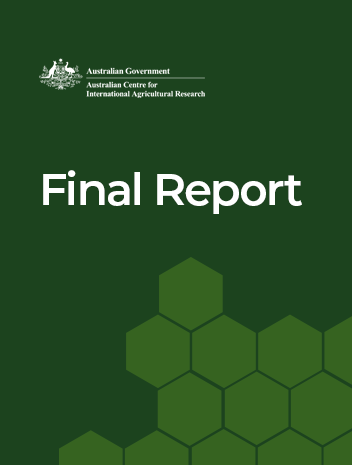- HomeHome
-
About ACIAR
- Our work
- Our people
-
Corporate information
- ACIAR Audit Committee
- Commission for International Agricultural Research
- Policy Advisory Council
- Agency reviews
- Executive remuneration disclosure
- Freedom of information (FOI)
- Gifts and benefits register
- Information publication scheme
- List of new agency files
- Contracts
- Legal services expenditure
- Privacy impact assessment register
- Commonwealth Child Safe Framework
- Benefits to Australia
- Careers
- 40 years of ACIAR
-
What we do
- Programs
- Cross-cutting areas
- Resources
- Where we work
-
Funding
- Research projects
- Fellowships
-
Scholarships
- John Allwright FellowshipScholarships to study in Australia for ACIAR partner country scientists to have Australian postgraduate qualifications
- ACIAR Pacific Agriculture Scholarships and Support and Climate Resilience Program
- Alumni Research Support Facility
- Publications
- News and Outreach
Project final report
Low cost water salinity sensor for smallholder irrigators in developing countries - final report
Date released
30 May 2017
Overview
This project aimed to develop technologies for smallholder irrigators to help farmers manage water on their farms.
Depletion of surface and groundwater resources has resulted in farmers using irrigation water with unsuitable salinity levels. Farmers have only known if water was too saline after it impacted their crop.
From the need for a simple, low cost sensor that small scale farmers can intuitively use to decide if water is suitable for irrigation or if leaching is required, this research project sought to develop a simple new sensor. The sensor needed to provide output in easily understandable form e.g. colours, rather than scientific units of conductance. The design of the sensor needed to combine an understanding of science in water salinity measurement techniques and the social process of adaptive learning amongst smallholder farmers.
The project evaluated 3 different salinity measurement alternatives:
- The SaltLight had very large measurement inaccuracy, extremely high cost, and some operational hardware faults.
- The Nutrient Meter model YM-2005A provided the best combination of measurement accuracy, ease of use, and cost of the five commercial hydroponics salinity meters. This unit has been supplied to users with re-labelling to indicate salinity risk in colour coded groupings.
- The in-house designed Chameleon EC Test Circuit best met the operational requirements. It was fully compatible with the ‘Arduino Mini’ board at the lowest cost. Further work will be needed to determine if it can successfully be incorporated into a low cost custom built meter.



